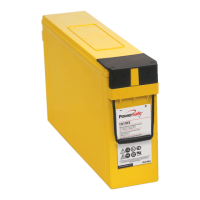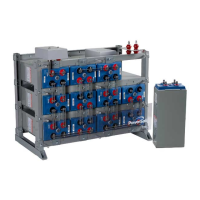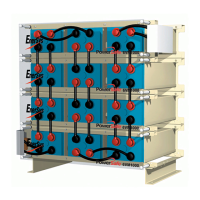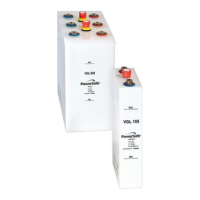6
Methods of charging
Charging time
The charge must be
stopped
When can the charge
start again?
Note
End of charge
Very important
Note
Cell voltage and
specific gravity
imbalance
Constant current
I = 0.053 C
10
Example for a battery of 500Ah
500 x 0.053 = 26.5A
Constant voltage
Voltage per cell: 2.35
Initial current limited to 0.1 C
10
Example for a battery of 500Ah
500 x 0.1 = 50A
Typically 6 to 15 hours, depending upon storage conditions.
Long or poor storage will increase the charge time.
If the temperature of the electrolyte reaches:
- temperate climate: 40°C (104°F)
- tropical climate: 50°C (122°F)
55°C (131°F) (maximum case)
When the temperature of the electrolyte is below:
- temperate climate: 30°C (86°F)
- tropical climate: 40°C (104°F)
If charging is stopped more than 3 times because of cell temperature rise, please
reduce the constant current value. This will simply increase the charge time.
Until all cell voltages and electrolyte specific gravities (corrected to 20°C) cease to
rise for three consecutive hourly readings.
Long or poor storage will increase the time to charge. Constant current charging is
preferable to ensure electrolyte consistency across the cells and a reasonable charge time.
If the temperature of the electrolyte is below 40°C, it is better to overcharge the
battery rather than to keep the battery undercharged.
Imbalances are possible after long or poor storage.
Example: charging at constant voltage a battery which has been stored in poor conditions,
24 cells in which only 6 cells have been kept in good storage conditions.
- charge at constant voltage 2.35 Volts per cell
- maxi voltage supplied by the charger 2.35 x 24 = 56.4 Volts
- the voltage of the best 6 cells rises quickly to 2.60 x 6 = 15.6 Volts
- 18 cells will be in average at 2.26 Volts per cell
when the battery voltage reaches 56.4 Volts 2.26 x 18 = 40.8 Volts
56.4 Volts
- at 56.4 Volts, the current falls off to a very small value. With this very low float current, the
charging time will be longer for the 18 cells at 2.26 Volts. Continue charging until the specific
gravity of the electrolyte for all cells rise to the nominal specific gravity at maximum level.
Initial charge
The initial charge is very important as it can affect the life and performance of the battery.
Cells must be fully charged before the battery is put into service. Charging must be continued until the specific
gravity of every cell reaches between 1.235 and 1.240 at 20°C (maximum level) - see section 5.
Details of charge at constant voltage
The voltage is maintained at a constant fixed value per cell.
If the voltage is limited to 2.30Vpc the battery will not reach the gassing point. Ensuring that the specific gravity of the
electrolyte within a cell is consistent will take longer.
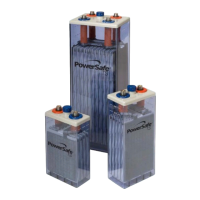
